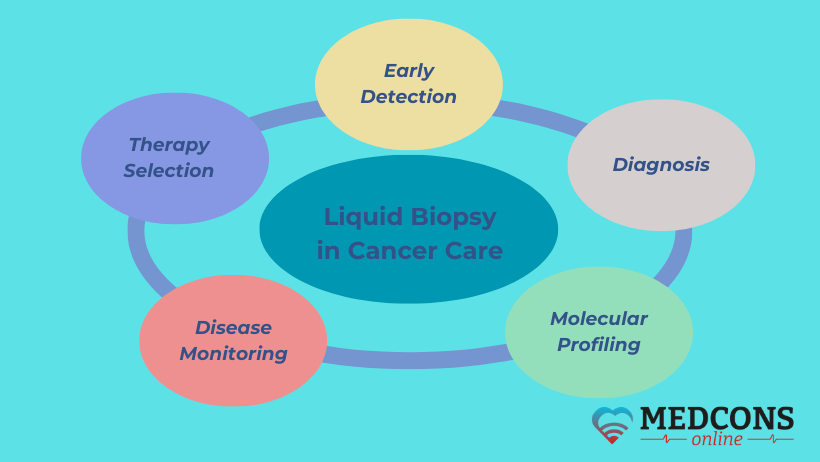
Usually a biopsy deals with tissue (epithelial, muscular, etc.). However, in recent years, scientists have increasingly been paying attention to the human body fluids, primarily blood.
Why liquid?
It was found out that cancer cells and fragments of their DNA or RNA can be detected in blood samples. Their analysis makes it possible to identify cancer at the earliest stages, select targeted therapies, monitor treatment results and timely detect disease relapses.
Advantages
A conventional biopsy is always a somewhat invasive procedure. In order to obtain the sought-for tissue fragment, doctors have to penetrate the body with a needle, an endoscope or a scalpel. Unpleasant sensations, the need for anaesthesia or even narcosis, the risk of bleeding are the inevitable "companions" of this process. In contrast, blood sampling is quite a routine event for most patients; it is easily tolerated and does not cause discomfort.
From the physician's point of view, liquid biopsy solves serious problems of the conventional one, such as:
- The need to apply sample preservation methods, which can distort the results of some molecular analyses.
- The so-called spatial heterogeneity of tumors (different parts of the same entity may have different genomic characteristics).
- Dynamic changes in tumor properties with the emergence of treatment-resistant subclones that were absent in the primary focus.
- Difficulty in obtaining a sufficient volume of material, especially in case of complex tumor locations.
Liquid material circulating in the bloodstream is quite easy to obtain in volumes required for the study. It can be done more than once without the risk of complications to tract genetic and molecular changes on "live" samples that have not been subjected to special processing. Thus, the diagnostic procedure called "liquid biopsy" becomes an attractive alternative to conventional techniques.
What is the purpose of a liquid biopsy?
The new technique allows to successfully solve the main tasks of diagnostic and therapeutic oncology, including:
- prevention (detection of cancer at an early stage),
- treatment planning (individual selection of therapy based on an accurate understanding of the molecular genetic profile of the tumor),
- monitoring the effectiveness of therapy,
- early relapse detection.

To implement these goals, tests have been developed that include different amounts and nature of the examined material.
The fundamental question when choosing a test is which of the two situations a case refers to:
- There is no cancer diagnosis or presumed cancer.
- There is already a cancer diagnosis or the presence of a certain malignant disease is suspected.
Further selection criteria are medical history data, including family history, the type and characteristics of the malignant disease, its stage, etc.
Available test options
Screening - designed to detect solid tumors (not related to the hematopoietic or lymphatic system).
The exam identifies circulating tumor cells (CTCs) that are highly likely to indicate the presence of cancer, as well as determines what kind of cancer may be present. It is recommended for people of 40 years and older, but can be performed at an earlier age, especially if risk factors are present, such as: a family history of cancer, known inherited gene mutations, obesity, type 2 diabetes, a low immune system, exposure to toxic chemicals/carcinogens.
Advantages: by simple blood sampling, it is possible to make sure that there is no malignant processes in the body or to find out about the presence of cancer at an extremely early stage and, thanks to timely treatment, to defeat the disease with minimal damage to health.
Diagnostic - recommended if a certain type of cancer is suspected (e.g. a self-reported lump in the chest or a visible mass in the lung), especially if taking a tissue sample is risky or impossible (as in the case of brain tumors).
Advantages: With a very safe procedure, it is possible:
- to identify patients with a high likelihood of cancer and prioritize their follow-up, as well as spare invasive procedures for those whose issue is most likely benign;
- to obtain reliable diagnostic information whenever a traditional biopsy is difficult or risky.
Intelligent liquid biopsies, which provide up-to-date information on cancer status, including early signs of disease progression and the underlying molecular mechanisms, can facilitate better clinical decision-making for more successful treatment and prognosis impovement.
Monitoring – are suitable for patients who have already been diagnosed with cancer, or those already receiving anti-tumor therapy, or are in remission.
During the test, circulating tumour cells, circulating tumour DNA (ctDNA) and circulating tumour RNA (ctRNA) are isolated from a blood sample and analyzed to determine molecular dynamics and tumor characteristics.
This allows dynamic monitoring of the disease course, providing a detailed real-time view of its spread (including evidence of relapse) and molecular dynamics, response to treatment, and potential innate/emerging mechanisms of drug resistance.
Advantages: provides a reliable and safe way to select or adjust a therapy plan, to assess treatment efficacy, and to prevent or detect relapse in time.
Where and how can a liquid biopsy be performed?
All over the world there are still just a few laboratories that offer this innovative technology. It is most common in the USA, but it is also available in Europe. The good news is that you don't always have to travel far to get anyour analysis. It is possible to arrange the delivery of a sampling kit to the patient's location and the return shipment of samples to the test site. To get an assistance in service arrangement as well as in test selection, please contact us in any way convenient for you.
References
- Alix-Panabières, Catherine; Pantel, Klaus (January 2013). "Circulating tumor cells: liquid biopsy of cancer". Clinical Chemistry. 59 (1): 110–118. doi:10.1373/clinchem.2012.194258. ISSN 1530-8561. PMID 23014601.
- "Liquid Biopsy - an overview | ScienceDirect Topics". www.sciencedirect.com. Retrieved 2023-11-08.

Comments — 0